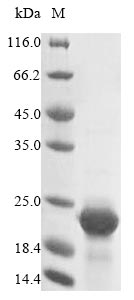Recombinant Mouse Cystatin-C (Cst3) is produced in E. coli and includes an N-terminal 10xHis-tag along with a C-terminal Myc-tag, which makes purification and detection more straightforward. The protein represents the complete mature form, covering amino acids 21-140. SDS-PAGE analysis confirms purity levels above 85%, making this product well-suited for research applications that demand highly specific and consistent recombinant protein.
Cystatin-C appears to be a cysteine protease inhibitor that researchers study extensively for its regulatory function in proteolytic pathways. It seems crucial for maintaining protease balance and may have important implications in research focusing on tissue remodeling, inflammation, and cellular homeostasis. Understanding how it interacts with other molecules is likely essential for revealing the mechanisms behind protease-related processes in biological systems.
Potential Applications
Note: The applications listed below are based on what we know about this protein's biological functions, published research, and experience from experts in the field. However, we haven't fully tested all of these applications ourselves yet. We'd recommend running some preliminary tests first to make sure they work for your specific research goals.
Mouse Cst3 is a cysteine protease inhibitor that requires precise folding, proper disulfide bond formation (with two conserved disulfide bonds), and specific tertiary structure for its functional activity in cathepsin inhibition. Cystatin-C is a small-molecular-weight extracellular inhibitor protein. Its activity does not rely on any complex post-translational modifications. Its function depends on forming the correct three-dimensional structure, which includes a pocket for binding to the target enzyme (cysteine protease). This structure is relatively stable and is relatively easy to fold correctly in the cytoplasmic environment of Escherichia coli. The dual N-terminal 10xHis-tag and C-terminal Myc-tag may sterically interfere with the protein's functional domains, particularly the protease-binding sites. While the protein may be soluble, the probability of correct folding with functional protease inhibitory activity is low without experimental validation.
1. Cysteine Protease Inhibition Assays
This application carries a significant risk without proper folding validation. Cystatin-C's inhibitory function requires precise tertiary structure and proper disulfide bonding for cathepsin binding. If correctly folded and active (verified through inhibition assays), the protein may be suitable for kinetic studies. If misfolded/inactive (unverified), inhibition assays will yield biologically meaningless results. The dual tags may sterically block the protease-binding interface.
2. Antibody Development and Validation
This application is highly suitable as antibody development relies on antigenic sequence recognition rather than functional protein folding. The full-length mature protein provides comprehensive epitope coverage for generating antibodies against mouse Cystatin-C. The dual tags offer additional epitopes for screening and validation purposes.
3. Protein-Protein Interaction Studies
This application requires proper folding validation. Cystatin-C interactions with proteases require precise tertiary structure. If correctly folded (verified), the protein may identify physiological interaction partners. If misfolded/unverified, there is a high risk of non-specific binding or failure to replicate genuine protease-inhibitor interactions.
4. Structural and Biophysical Characterization
These studies are essential for determining the folding status of the protein itself, not the native Cst3. Techniques should include circular dichroism spectroscopy to assess secondary structure, size-exclusion chromatography to evaluate oligomeric state, and disulfide bond analysis. However, the dual tags may interfere with crystallization for high-resolution structural studies.
5. Comparative Species Studies
Meaningful comparative studies require native protein conformation and functional activity. If correctly folded and active (verified), the protein enables valid evolutionary comparisons of inhibitory properties across species. If misfolded/inactive (unverified), comparative analyses would yield misleading evolutionary insights
Final Recommendation & Action Plan
The E. coli expression system is fundamentally limited for producing functional Cystatin-C due to its inability to support proper disulfide bond formation. Begin with Application 4 (Structural Characterization) to assess folding quality through CD spectroscopy, SEC, and validate disulfide bond formation. Test inhibitory activity against known cathepsins before considering functional applications. Applications 1, 3, and 5 require rigorous functional validation. Application 2 (antibody development) can proceed immediately. For reliable Cystatin-C research requiring native functionality, use mammalian expression systems that support proper disulfide bonding and folding.






